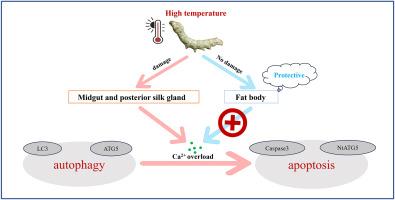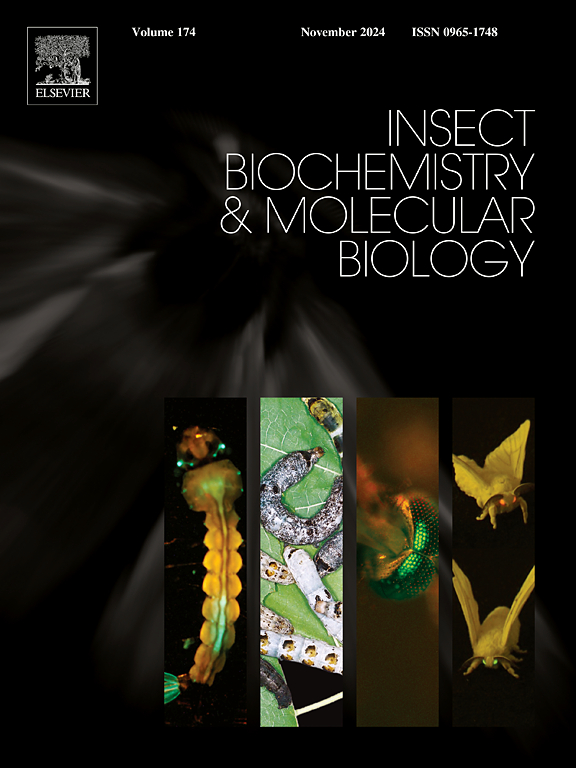基于钙离子稳态的高温对家蚕不同器官自噬和凋亡影响的研究
IF 3.7
2区 农林科学
Q2 BIOCHEMISTRY & MOLECULAR BIOLOGY
引用次数: 0
摘要
高温胁迫对家蚕生长发育、丝蛋白合成和代谢等生理功能有不同程度的影响。为了研究其潜在的机制,我们基于钙离子(Ca2+)稳态,研究了高温处理(30°C和35°C)下家蚕中肠、后丝腺(PSG)和脂肪体的自噬和凋亡机制。结果表明,高温处理显著降低了家蚕体重。此外,高温处理可导致家蚕中肠和PSG损伤,并伴有细胞内Ca2+超载,自噬相关基因的转录水平以及LC3-I和LC3-II蛋白的表达均受到影响。ATG5和NtATG5蛋白水平显著升高,凋亡关键基因转录及caspase-3和cleaved - caspase-3蛋白水平升高。综上所述,这些结果表明高温通过Ca2+介导诱导家蚕自噬,并促进其向凋亡的转化。此外,高温被证明对脂肪体造成的损伤最小,并且不能诱导自噬或凋亡的上调。本研究不仅揭示了高温胁迫下家蚕各器官Ca2+稳态、自噬和凋亡之间复杂的相互作用,而且揭示了热应激在不同器官间的差异效应。这些发现为选育耐热蚕品种提供了理论依据。本文章由计算机程序翻译,如有差异,请以英文原文为准。

Study on the effects of high temperature on autophagy and apoptosis in different organs of Bombyx mori based on calcium ion homeostasis
High-temperature stress differentially affects physiological functions in Bombyx mori, including growth and development, silk protein synthesis, and metabolism. To investigate the underlying mechanisms, we explored the mechanisms of autophagy and apoptosis in the midgut, posterior silk gland (PSG), and fat body of B. mori under high-temperature treatment (30 °C and 35 °C), based on calcium ion (Ca2+) homeostasis. The results demonstrated that high-temperature treatment significantly reduced the body weight of B. mori. Furthermore, high-temperature treatment could cause damage to the midgut and PSG of B. mori, accompanied by intracellular Ca2+ overload, and the transcription levels of autophagy-related genes as well as the expression of LC3-I and LC3-II proteins are both affected. The protein levels of ATG5 and NtATG5 were significantly increased, while the transcription of key apoptotic genes and the protein levels of caspase-3 and cleaved caspase-3 were elevated. Collectively, these results indicated that high temperature induced autophagy in B. mori through Ca2+ mediation and promoted its conversion to apoptosis. Additionally, high temperature was demonstrated to inflict minimal damage on the fat body and failed to induce upregulation of autophagy or apoptosis. This study not only unveiled the intricate interplay among Ca2+ homeostasis, autophagy, and apoptosis in various organs of B. mori under high-temperature stress, but also revealed differential effects of heat stress across distinct organs. These findings provide a theoretical foundation for the breeding of thermotolerant silkworm varieties.
求助全文
通过发布文献求助,成功后即可免费获取论文全文。
去求助
来源期刊
CiteScore
7.40
自引率
5.30%
发文量
105
审稿时长
40 days
期刊介绍:
This international journal publishes original contributions and mini-reviews in the fields of insect biochemistry and insect molecular biology. Main areas of interest are neurochemistry, hormone and pheromone biochemistry, enzymes and metabolism, hormone action and gene regulation, gene characterization and structure, pharmacology, immunology and cell and tissue culture. Papers on the biochemistry and molecular biology of other groups of arthropods are published if of general interest to the readership. Technique papers will be considered for publication if they significantly advance the field of insect biochemistry and molecular biology in the opinion of the Editors and Editorial Board.

 求助内容:
求助内容: 应助结果提醒方式:
应助结果提醒方式:


